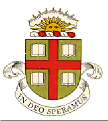 EN224: Linear Elasticity
EN224: Linear Elasticity 
 EN224: Linear Elasticity
EN224: Linear Elasticity 
Division of Engineering
5.2 Complex Variable Solutions to Anti-Plane Shear Problems
Complex variable methods are among the most powerful methods for solving Laplace’s equation. The approach is based on the observation that both the real and imaginary parts of an analytic function satisfy Laplace’s equation. To see this, consider a complex function
If f is analytic, the derivative with respect to z is path independent, which requires
so that
Stresses and forces determined from the complex potential
If we use the real or imaginary part of an analytic function as a solution to an anti-plane shear problem, we can determine the stresses from f(z) directly. Note that
Suppose we choose
, then
Where
denotes the complex conjugate.
If we choose
, one may readily show that the imaginary part of f(z) is related to the resultant force acting on an arc within the solid.
Consider a line segment AB within the solid. Note that the resultant force acting on the arc is
Now, observe that
and
Hence
Finally,
Similarly, if we choose
then
In this case, one may show that the resultant force acting on an arc is
This is messy, so we normally generate the displacement from the real part of f.
Some examples of complex potentials for Anti-Plane shear
An immediate consequence of this observation is that the real and imaginary parts of any analytic function will solve some anti-plane shear problem. We can generate solutions by superposing analytic functions.
The fundamental solution for an infinite solid
For example, guided by the solution to the 3D Kelvin problem, we might consider the function
This is analytic everywhere except the origin. Let us choose
. Using the results outlined in the preceding subsection, we may readily compute the resultant force acting on any arc enclosing the origin:
Observe
so that
Thus, the resultant force on any contour enclosing the origin is the same: there must be an equal and opposite point force applied at the origin. Choosing
will therefore generate the anti-plane shear version of the normalized Kelvin state: that is to say, a line load of unit magnitude (per unit length of line) acting in the direction at the origin.
Screw Dislocation
What happens if we choose
The displacement field is evidently multiple valued, with a jump of magnitude b across any radial branch cut. Furthermore, applying the results of the preceding section, we see that the resultant force on any closed contour vanishes. This is therefore the displacement for a screw dislocation at the origin.
Superposition
Other solutions may be generated using superposition. For example, the fields due to a line load below the surface of a half-space may be constructed as follows. The stress field due to a point force at (0,-h) is
Observe that
is antisymmetric, so we can free the
plane from traction by superposing a second point force at (0,h).
The stress due to a line load below the surface of a half-space is therefore
The effects of a rigid boundary may be found using a similar approach, and of course we could find the stresses due to a screw dislocation near a free surface or a rigid boundary by superposition. One can also superpose two screw dislocations to construct a solution for a screw dislocation within a cylinder.